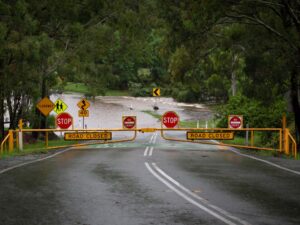June 4, 2025
2025 has seen the driest spring in nearly 70 years, and April was the sunniest since records began in 1910. Meteorologists are warning of the potential for a summer drought, with subsidence, flash flooding, and wildfire risks highlighted as concerns.
In July 2022, when temperatures soared to 40.3 degrees Celsius, one of several wildfires around the London area destroyed 18 homes and decimated the village of Wennington. On the other hand, October 2022 through to March 2024 was England’s wettest 18 months on record.
The propensity for increasingly frequent and more intense weather events – heatwaves and droughts, stronger storms and heavy rainfall – is clearly becoming consistent. How much more evidence do we need before everyone starts to take this risk seriously?
Storm claims data
In the winter of 2023/24, we saw 12 named storm events across the UK. By comparison, in the 2024/25 storm season, there were only five named storms, but in terms of total claims volumes, both seasons were very similar. However, the cost of claims differs significantly between events, particularly when heavy rain is a feature. For example, while Storm Bert resulted in fewer losses than Darrah, it had a higher proportion of flood claims, which are significantly more expensive to repair. Consequently, Storm Bert was a costlier event for the insurance industry.
In a report published by the Climate Change Committee, 30 April 2025, Baroness Brown, Chair of the Adaptation Committee said: “We have seen in the last couple of years that the country is not prepared for the impacts of climate change. We know there is worse to come, and we are not ready – indeed, in many areas, we are not even planning to be ready. Ineffective and outdated ways of working within Government are holding back the country’s ability to be future-fit. Failing to act will impact every family and every person in the country.” 1
This report also highlighted that 6.3 million properties in England are in areas at risk of flooding from rivers, surface water and the sea. This is predicted to rise to around 8 million (25% of all properties) by 2050.
Promoting resilience
The insurance industry has a responsibility to advise customers on the potential impact of climate change on their property and how we can help mitigate that risk through insurance. The benefits are clear – with robust property resilience measures in place, customers won’t need to make so many claims, insurers’ costs will be reduced, and insurance cover will remain more affordable.
Brokers are well-positioned to raise awareness and advise customers on adaptations that will help protect their property and businesses – for example, homeowners’ eligibility for the Build Back Better programme. Some insurance policies also include green clauses, where insurers will pay the additional funding required for greener and more resilient repairs. In the event of a claim, are brokers actively promoting the benefits of these clauses?
Commercial customers, in particular, must be encouraged to take a longer-term view. Spending money on resilience measures now ensures that the business is far less vulnerable to extreme weather events in the future.
We could do more
The government recently increased the landfill tax by 25% to encourage people to recycle rather than send goods to landfill. Many items that form part of an insurance claim can be perfectly repaired rather than replaced. Cars, for example – reconditioned parts work just as well as new ones.
Brokers play a key role in changing customer and client perceptions. We don’t always need new things, and clients need to appreciate that they also have a responsibility to reduce their carbon footprint.
We’re partnering with many insurers, sharing our knowledge and expertise to advance their carbon emissions reduction campaigns on insurance-related building repairs. This includes promoting low-carbon material options to customers. We’re also collaborating closely with one client to encourage greater domestic customer uptake of the Government’s Build Back Better scheme. But we could all do more.
A recent video produced by The Economist reports that even if all global sustainability and net-zero promises are met, there’s still a 1 in 20 chance that the world will be at least two degrees warmer by the end of the century. This means that children born today are seven times more likely to face extreme weather events than their grandparents.
We are in danger of letting ongoing economic challenges overshadow the crucial importance of pursuing sustainable solutions. But it’s what we do today – or, more importantly, don’t do – that affects us all for the future.
1 https://www.theccc.org.uk/2025/04/30/the-country-is-not-prepared-for-climate-impacts-say-advisors/
Tags: storms United Kingdom



